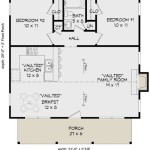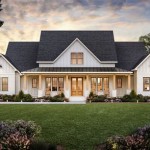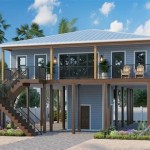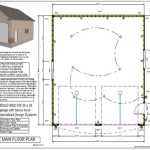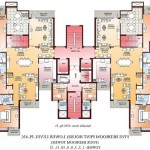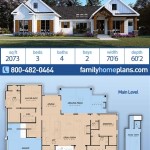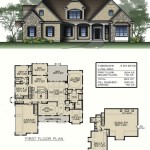Inexpensive House Plans To Build: A Practical Guide
Building a house represents a significant financial undertaking for most individuals and families. Carefully navigating the construction process to minimize costs without compromising structural integrity or long-term livability becomes paramount. Inexpensive house plans offer a strategic starting point, providing a blueprint for a more budget-conscious construction project. These plans prioritize efficiency in design, material usage, and buildability, allowing homeowners to realize their dream of homeownership without exorbitant expenses.
The term "inexpensive" in this context does not equate to poor quality or limited functionality. Rather, it signifies a focus on smart design principles that reduce waste, streamline construction, and leverage cost-effective materials. These plans often incorporate smaller footprints, simpler layouts, and readily available resources, resulting in a more affordable and manageable building process.
Choosing an inexpensive house plan requires careful consideration of individual needs, site conditions, and local building codes. It demands a thorough understanding of the factors that contribute to overall construction costs and a proactive approach to identifying opportunities for cost-saving measures. This process involves evaluating various plan options, comparing material specifications, and consulting with experienced builders and contractors.
Understanding the Factors that Influence House Construction Costs
Several factors contribute significantly to the overall cost of building a house. These factors interact with each other, and understanding their interplay is crucial for making informed decisions about house plans and construction strategies. Land costs, size and complexity of the house, materials used, labor rates, and permitting fees represent some of the major determinants of cost.
Land costs vary dramatically depending on location, accessibility, and zoning regulations. In urban areas or desirable suburban neighborhoods, land prices can constitute a substantial portion of the total construction budget. Rural areas generally offer more affordable land options but may present challenges regarding infrastructure access and utility connections.
The size and complexity of the house directly impact material requirements and labor hours. Larger houses necessitate more materials for the foundation, framing, roofing, and interior finishes. Intricate designs with unusual angles, multiple stories, or custom features require specialized labor and increase construction time. Simple, rectangular designs with minimal ornamentation are generally more cost-effective to build.
The choice of building materials significantly influences construction costs. Premium materials like hardwood flooring, granite countertops, and custom cabinetry command higher prices than more affordable alternatives like laminate flooring, laminate countertops, and stock cabinetry. Selecting durable, readily available materials that meet aesthetic preferences and functional requirements helps control costs. Furthermore, exploring sustainable and locally sourced materials can often be a cost-effective and environmentally responsible choice.
Labor rates vary depending on location, skill level, and the demand for construction services. Obtaining multiple bids from qualified contractors and subcontractors helps ensure competitive pricing. Clearly defined contracts that outline the scope of work, payment schedules, and dispute resolution mechanisms are essential for managing labor costs effectively. Owner-builder arrangements can potentially save money on labor, but they require significant time commitment, construction knowledge, and project management skills.
Permitting fees and inspection requirements vary by municipality. These fees cover the cost of plan reviews, building inspections, and ensuring compliance with local building codes and regulations. Understanding these fees and budgeting for them accordingly prevents unexpected expenses during the construction process.
Key Features of Inexpensive House Plans
Inexpensive house plans often incorporate specific design features that promote affordability without sacrificing functionality or aesthetic appeal. These plans prioritize efficiency in space utilization, material usage, and construction techniques. Smaller footprints, open floor plans, simple rooflines, and readily available materials characterize these cost-effective designs.
Smaller footprints minimize the amount of materials required for the foundation, framing, roofing, and exterior finishes. Compact designs also reduce heating and cooling costs, leading to lower utility bills over the life of the house. Efficient space planning ensures that every square foot is utilized effectively, eliminating wasted space. Smaller houses are also easier to maintain and clean, contributing to long-term cost savings.
Open floor plans create a sense of spaciousness and improve natural light penetration. Eliminating walls between living areas reduces material requirements and simplifies construction. Open layouts also promote social interaction and create a more flexible living environment. Carefully planned furniture arrangements and strategic use of area rugs can help define distinct zones within the open space.
Simple rooflines, such as gable or shed roofs, are easier and less expensive to construct than complex roof designs with multiple gables, dormers, or valleys. Simple roofs require less material and less labor, reducing overall construction costs. They are also less prone to leaks and require less maintenance over time. Thoughtful design can incorporate simple rooflines while still achieving an aesthetically pleasing and architecturally interesting appearance.
Readily available materials, such as lumber, plywood, and standard-sized windows and doors, are generally less expensive than custom-made or specialty materials. Using these materials streamlines the construction process and reduces lead times. Choosing materials that are readily available locally can further reduce transportation costs and support local businesses. Smart material choices do not necessarily mean sacrificing aesthetics; many affordable materials offer a wide range of styles and finishes.
Finding and Evaluating Inexpensive House Plans
Numerous resources offer inexpensive house plans, ranging from online retailers to architectural firms. Thoroughly researching and evaluating these options is crucial for finding a plan that meets individual needs, budget constraints, and site conditions. Online plan repositories, architectural firms specializing in affordable housing, and pre-designed house plan catalogs represent some of the avenues for finding suitable plans.
Online plan repositories offer a vast selection of house plans in various styles and sizes. These websites often provide detailed information about the plans, including floor plans, elevations, material lists, and estimated construction costs. However, verifying the accuracy and completeness of the information is essential before purchasing a plan. Reading reviews from other builders and homeowners who have used the plan can provide valuable insights.
Architectural firms specializing in affordable housing can provide customized plans that meet specific needs and budget constraints. These firms have experience designing efficient and cost-effective houses. Working with an architect allows for incorporating site-specific considerations and personal preferences into the design. While custom design services may involve higher upfront costs, they can potentially lead to long-term cost savings by optimizing the design for efficiency and minimizing waste.
Pre-designed house plan catalogs offer a curated selection of plans that have been pre-approved by building code officials. These catalogs often feature a variety of styles and sizes, catering to different preferences and budgets. Pre-designed plans can save time and money compared to custom designs, as they have already been developed and tested. However, they may require modifications to meet specific site conditions or individual needs.
Evaluating a house plan involves considering several factors, including the size and layout of the house, the materials specified, and the construction techniques employed. Ensuring that the plan meets local building codes and zoning regulations is paramount. Consulting with a qualified builder or contractor to obtain an estimate of construction costs is essential before committing to a plan. Thoroughly reviewing the plan and identifying any potential issues or concerns before construction begins can prevent costly changes later on.
Modifying an existing house plan represents another cost-effective approach. Often, small alterations to a pre-existing design can tailor the house to specific needs without incurring the full expense of a custom design. Adjustments to room sizes, window placements, or interior finishes can significantly impact the overall cost and functionality of the house. Consulting with a design professional is crucial to ensure that any modifications comply with building codes and do not compromise the structural integrity of the house.

Est House Plans To Build Simple With Style Blog Eplans Com

Affordable House Plans Our Est To Build Blog Homeplans Com

Affordable House Plans Our Est To Build Blog Homeplans Com

Building On The Affordable House Plans Of 2024 Houseplans Blog Com

Est House Plans To Build Simple With Style Blog Eplans Com

Building On The Affordable House Plans Of 2024 Houseplans Blog Com

Affordable House Plans Our Est To Build Blog Homeplans Com
What Is The Est Type Of House To Build Blog Floorplans Com
Est House Plans To Build Simple With Style Blog Eplans Com

Affordable Home Ch3 Floor Plans And Data

